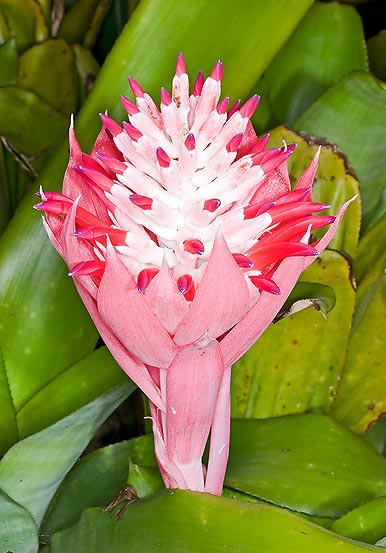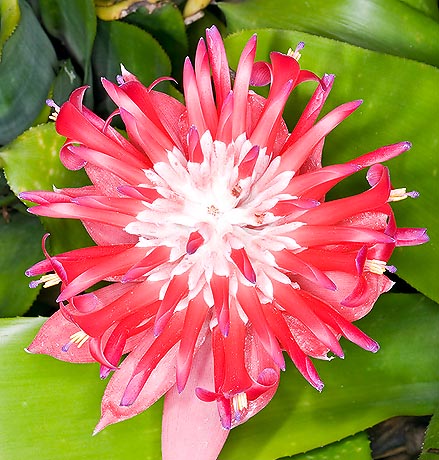Family : Bromeliaceae

Text © Pietro Puccio

English translation by Mario Beltramini

Seen from the side, the big inflorescence seems a torch © G. Mazza
The Billbergia pyramidalis (Sims) Lindl. (1827) is native to Brazil, Cuba, French Guyana, Leeward Islands, Venezuela and Windward Islands; it grows both in the mountain pluvial forests and in the costal ones with the typical sandy soils, colonizing ample extensions in the under-wood.
The genus is honoured to the Swedish botanist Gustav Johann Billberg (1772-1844); the Latin name of the species “pyramidalis” = pyramidal, refers to the shape of the inflorescence.
Common names: “flaming torch”, “foolproof plant”, “queen’s tears”, “summer torch” (English).
Evergreen, herbaceous plant, monocarpic (bearing fruit only one time during its existence), acaulescent, epiphytic, it has a funnel-shaped rosette, broad about 30cm and 50 cm (inflorescence included) tall, formed by several leaves placed in way to form a central cavity usually full of water. The leaves are linear-lanceolate, ascending, 50-60 cm long and 3-6 cm broad, of an emerald green colour and covered by microscopic grey scales which in the lower side often are disposed in horizontal bands; the edges are furnished of brown thorns.
The inflorescence, at the centre of the rosette, is formed by an about 25 cm long floral scape covered by a white down and provided of thin bracts, longer than the internodes, of pink colour with microscopic grey scales, which get thicker in the superior side under the inflorescence. The scape ends with a racemose inflorescence with the shape of an overturned pyramid, tall about 12 cm and 6 cm broad, with just hinted floral bracts, or missing completely.
The numerous flowers have 5 cm long, red tending to the violet by the apex, sepals, covered by a white powder, and bright red gradated to the violet by the apex, petals, long up to about 8 cm and bent in the terminal part. The fruits are fleshy, about 2 cm long and of a violaceous colour, berries, containing several fusiform, 2-3 mm long, seeds. It easily reproduces by vegetative way through the new plants which originate, numerous, at the base of the plant and which can be detached when they have reached the size of one third of the mother plant; the plants obtained in this way take only one year for reaching the floriferous maturity.
Should we wish to reproduce it by seed, this is to be distributed on the surface of a fibrous substratum kept constantly humid and placed in very luminous location, but not on the direct sun, being the germination induced by the light (positively photoblastic seeds). Since long time, the plant is one of the most popular of the genus, thanks to its adaptability to different cultivation conditions and to the reproductive facility, in spite of the unusually short duration of the inflorescence for a bromeliad, from one to two weeks, even if in tufted specimens we can have several blossoming during the year. It is cultivated in open air in the tropical and subtropical climate countries, even with marked seasons due to its resistance to long periods of drought, both as epiphytic on the low branches of the trees, and as terrestrial on preferably sandy, aerated, draining and rich of organic substance substrata.

The numerous flowers, curved at the apex, may reach the 8 cm © G. Mazza
It lives well and blossoms both in shade and in semishade and is able to colonize in short time wide spaces with its robust stolons, long 5-10 cm, it is therefore perfect for giving a note of colour, with its foliage and the inflorescences, even to the darker corners of the garden. Thanks to its natural resistance to the soils moderately saline and to the marine aerosols, it can be cultivated also not far away from the sea.
Its cultivation in open air can be tried also in warm temperate climates, as it bears, for short time, temperatures as down as -3°C, better if sheltered from the winter rains, seen that the humidity and the low temperatures render it more sensitive to rottenness. In pot for indoor decoration, on porous and draining substrata, like the classical one for the orchids formed by minced bark and rough peat, with addition of sand or other inert material, it can be placed both in poorly luminous locations and in very luminous, by indirect light, ones with temperatures which is good to be kept over the 14°C, best 20-24°C.
Watering must be regular in summer, but the substratum must be left to dry up before giving water again, and reduced in winter and local humidity, in presence of dry air and high temperatures, it can be increased with nebulisations utilizing water at room temperature and not calcareous in order to avoid anti-aestethic dots on the leaves. In summer, some water cane be left in the central cavity formed by the rosette of the leaves, renewing same frequently, thus to avoid the formation of mosquito larvae nests, whilst in winter it is better to leave it dry for avoiding possible rottenness.
Synonyms: Bromelia pyramidalis Sims (1815); Billbergia pyramidalis var. bicolor Lindl. (1828); Bromelia nudicaulis Rchb. (1829); Billbergia thyrsoidea Mart. ex Schult. & Schult.f. (1830); Tillandsia farinosa Schult. & Schult.f. (1830); Billbergia bicolor Lodd. (1832); Billbergia atrorosea Drapiez (1834); Billbergia loddigesii Steud. (1840); Pitcairnia fastuosa C.Morren (1847); Billbergia splendida Lem. (1852); Jonghea splendida Lem. (1852); Billbergia croyana De Jonghe ex Lem. (1854); Billbergia miniatorosea Lem. (1855); Billbergia thyrsoidea var. zonata de Vriese (1855); Billbergia fastuosa (C.Morren) Beer (1856); Billbergia longifolia K.Koch & C.D.Bouché (1856); Billbergia paxtonii Beer (1856); Billbergia punicea Beer (1856); Billbergia pyramidalis var. croyana E.Morren (1873); Billbergia pyramidalis var. farinosa E.Morren (1873); Billbergia pyramidalis var. zonata (de Vriese) E.Morren (1873); Billbergia thyrsoidea var. fastuosa E.Morren (1873); Billbergia thyrsoidea var. miniatorosea (Lem.) E.Morren (1873); Billbergia thyrsoidea var. splendida (Lem.) E.Morren (1873); Billbergia lemoinei André (1885); Billbergia andegavensis André (1886); Billbergia schultesiana Baker (1889); Billbergia setosa Baker (1889); Billbergia pyramidalis var. concolor L.B.Sm. (1954); Billbergia pyramidalis var. vernicosa E.Pereira (1979); Billbergia pyramidalis var. lutea Leme & W.Weber (1984).
→ For general notions about BROMELIACEAE please click here.
